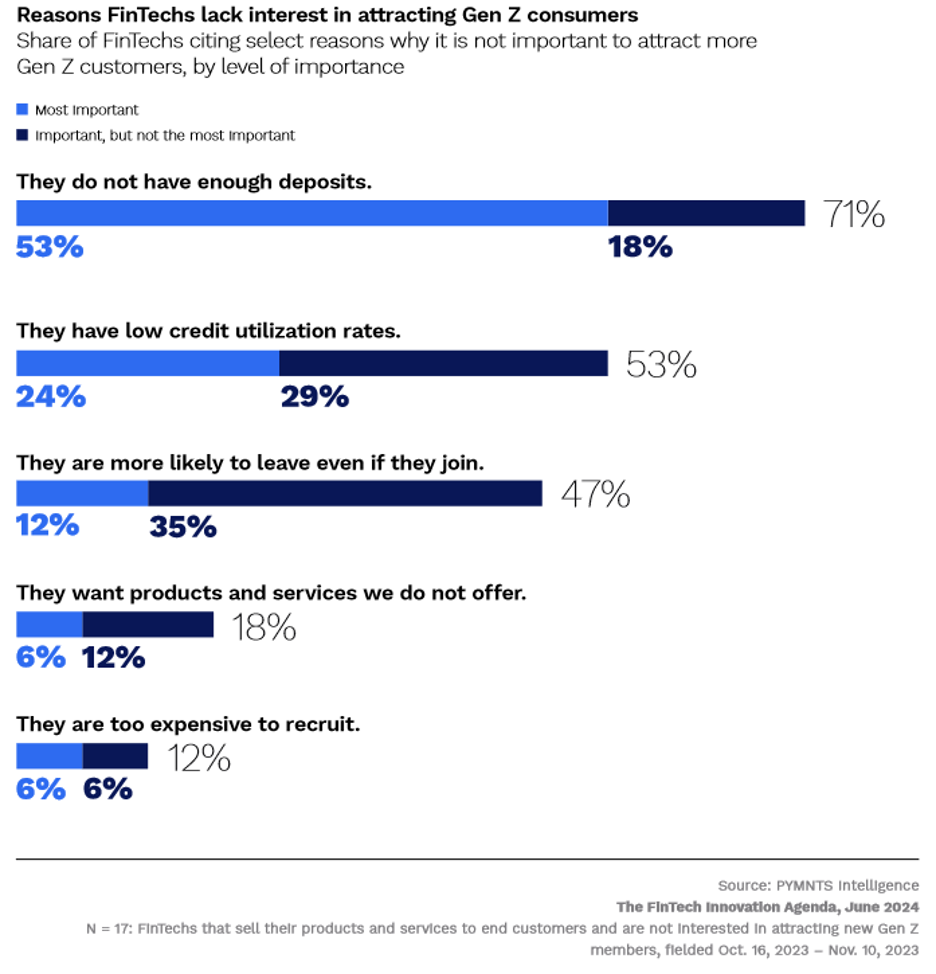62% of FinTechs Develop Products With Gen Z Consumers in Mind

As we recently reported, credit unions (CUs) are aggressively marketing toward Generation Z consumers. Ninety-five percent of them are focused on convincing Gen Z to join their membership rolls.
FinTechs? Not so much. According to PYMNTS Intelligence data, only 62% of financial technology companies are developing products with Gen Z consumers in mind.
As we reported in “The FinTech Innovation Agenda,” a report created in collaboration with Velera (formerly PSCU/Co-op Solutions), approximately seven in 10 FinTechs say Gen Z consumers simply do not make enough deposits to justify efforts to win them over as customers.
Yet, this demographic group would appear to be an ideal segment for FinTechs to pursue. Afterall, Gen Z is made up of predominantly digital-first consumers who value the convenience of mobile banking and digital payments, something many FinTechs recognize.
Forty-two percent of FinTechs say attracting more Gen Z consumers is very or extremely important to meeting their business goals (which is noteworthy, but still falls far short of the 95% of CUs who say attracting more Gen Z members is highly important).
Still, 59% of FinTechs acknowledged that Gen Z consumers represent a growing market, while 49% say Gen Z consumers are highly connected and can lead to further expansion of their account holder base.

Given this recognition, why does Gen Z inspire so little interest among FinTech executives?
As the figure above illustrates, a significant share of FinTechs do not see enough value in trying to attract them. As mentioned, 71% said that Gen Z consumers do not make enough deposits, with 53% citing this as their most important reason. Fifty-three percent said Gen Z consumers have low credit utilization rates, with 24% citing this as their most important reason.
Account holder churn ranks third, at 47%. Interestingly, just 12% cite Gen Z churn as the most important reason, suggesting that FinTechs may be too focused on the short term and may not realize the potential long-term value in winning over this cohort. In a separate report, “How Credit Union Innovation Can Drive Gen Z Engagement,” PYMNTS Intelligence found that Gen Z consumers are projected to increase their spending by as much as six times by 2030.
If there is a lack of focus among FinTechs on Gen Z consumers, it doesn’t necessarily mean they won’t benefit from the innovations that FinTechs are deploying.
As our more recent report reveals, about half of FinTechs currently sell their products or services to CUs, a trend that has been on the rise since hitting a low of 36% in early 2022. In fact, about eight in 10 FinTechs view themselves more as vendors serving CUs rather than competitors, indicating that FinTechs and CUs will likely work together for the foreseeable future.
In other words, because CUs are aggressively marketing their services toward Gen Z, those consumers are highly likely to gain access to FinTech innovations, after the fact, through CU memberships.




